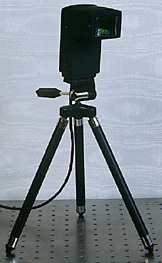


Virtual Retinal Display main page
Virtual Retinal Display (VRD) Group

How the VRD Works
The Virtual Retinal Display (VRD) team has been focused on developing improvements to the current prototype systems and on creating the parts needed for future prototypes. The VRD, based on the concept of scanning an image directly on the retina of the vi ewer's eye, was invented at the HIT Lab in 1991. The development program began in November 1993 with the goal of producing a full color, wide field-of-view, high resolution, high brightness, low cost virtual display.
Two prototype systems are currently being demonstrated. The first is a bench mounted unit that displays a full color, VGA (640 by 480) resolution image updated at 60 Hertz. It operates in either an inclusive or see-through mode. The second is a portable unit, displaying a monochrome, VGA resolution image. The portable system is housed in a briefcase allowing for system demonstrations at remote locations (see photo above).
Techniques that expand the system's exit pupil, making it easier to align one's eye to the display, have been developed and demonstrated for a monochrome display. Work is continuing to optimize the design and to develop components that will expand the pup il of the color system.
The largest component in the portable system is the commercially purchased vertical (60 Hertz) scanner. A new vertical scanner is being designed that should significantly decrease devices size and cost. Once this design is complete a head-mounted demonstration prototype will be assembled.
Commercial applications of the VRD are being developed at Microvision Inc.
The VRD is currently being adapted for use as a 3D display in our True3D Displays project; and related but different technologies are in use in the Scanning Fiber Endoscope.
Sponsoring Agencies
- National Science Foundation
- NSF Grant #DMI-98-1294
- NSF Grant #DMI-98-01294AM01
- CISE/IRI 9703598
- NSF Grant #DMI-98-01294AM01
Contacts
Thomas A. Furness III <tfurness![]() hitl.washington.edu>
hitl.washington.edu>